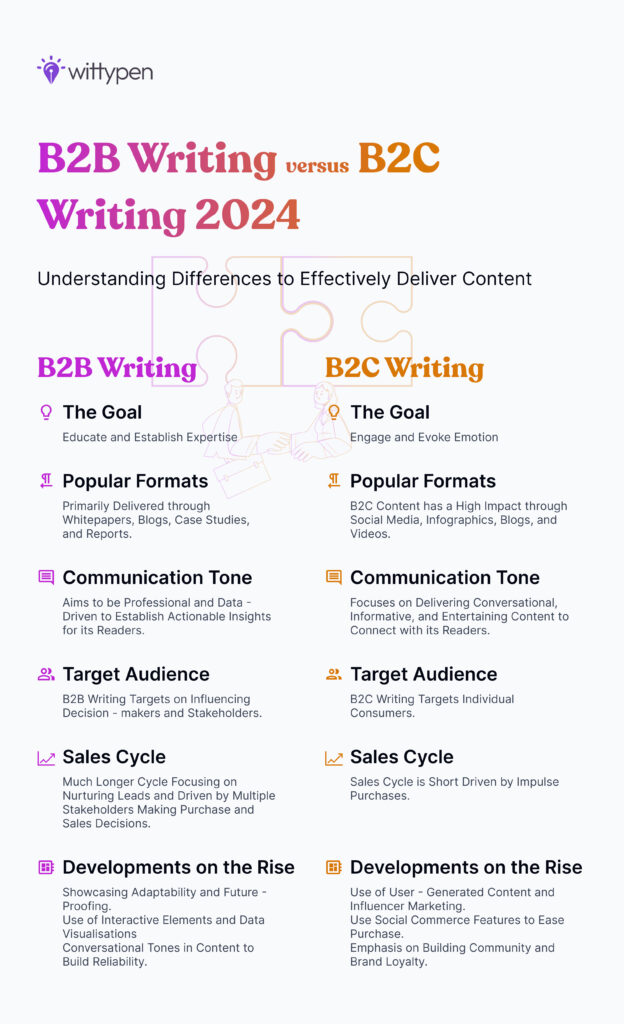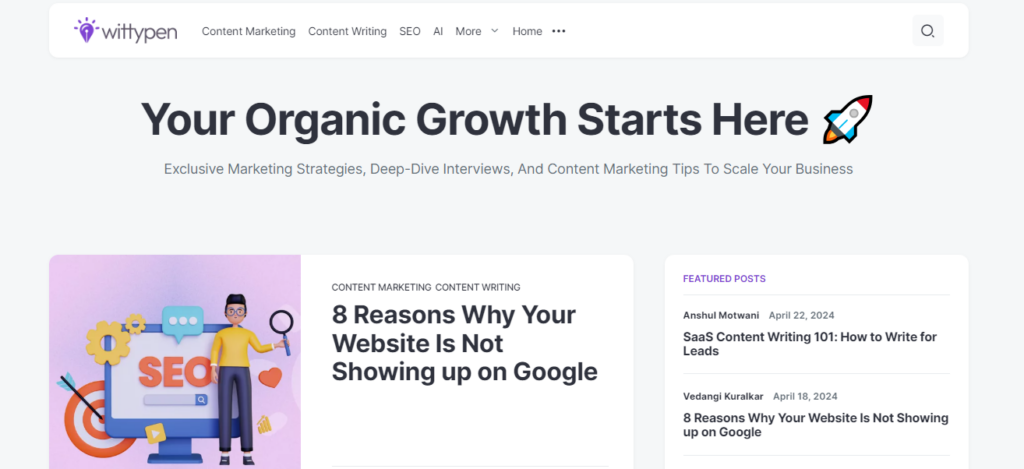Table of Contents
- What is B2B Writing?
- B2B vs. B2C Writing: Clearing Up Differences
- Why Use B2B Writing?
- A Deep Dive Into Types of B2B Writing
- Tips for Writing B2B Content and Best Practices
- The Importance of Monitoring B2B Content Performance
- Key Metrics to Track for B2B Content
- Tools for Analysing B2B Content Effectiveness
- Conclusion
What is B2B Writing?
The B2B, in B2B Writing, stands for ‘Business-to-Business‘. As the name gives some of it away, B2B writing is when businesses create content, keeping other businesses in mind as a part of their target audience.
While the popular content forms are blogs or case studies, the evolving nature of business has also brought about a broader and more robust scope to B2B writing. Along with the popular long-form content, B2B writing has significantly impacted social media marketing strategies as well.
Ultimately, making the most impact in B2B writing lies in meeting the needs of a business, not direct consumers.
With this quick preview, let’s highlight the key reasons B2B writing is a must for every business.
B2B vs. B2C Writing: Clearing Up Differences

Copy Credits: Venkataraman Mahalingam
Why Use B2B Writing?
To shed light on the importance of B2B, here are the three key reasons businesses ought to use B2B content writing,
Leads & Sales
B2B writing has the power to boost reputation and awareness. In addition to these two elements, high-quality content, subtle but strategic CTAs, research, well-structured testimonials, and delivery, holds the potential to attract qualified leads and boost sales. You’ll be amazed to know that according to Hubspot, blogs and website content are the two channels with the largest ROIs.
Balanced Cost Impact
Among the many effective B2B marketing channels, like paid ads and events, B2B writing delivers a higher impact at lower costs. B2B writing formats, such as blogs and case studies, drive organic web traffic, and since organic business growth is unpaid, it is a very cost-effective long-term strategy.
Brand Awareness
When delivered consistently through strategic channels, B2B writing allows a business to quickly reach a wider audience and gain a positive brand image. In fact, 84% of B2B marketers confirm that content boosts brand awareness and is one of the pertinent goals for businesses worldwide.
Position as a Thought Leader
B2B writing helps establish a business’s expertise in the field by showcasing its willingness to impart knowledge and educate its viewers and clientele. With quality B2B writing, a business has the potential to be regarded as a thought leader in the field, boosting trust and reliability metrics amongst potential clients.
Since achieving such crucial business goals has been established as the intent behind B2B writing, before understanding how to create impactful B2B writing content, it is also essential to know how it stands apart from any other business model.
A Deep Dive Into Types of B2B Writing
With a clear understanding of the focus, purpose, and critical details of B2B writing, let’s dive a little deeper into the popular formats of B2B content writing, what they are used for and their impact. Here are the top types of B2B writing,
1. Blogs
For B2B content creation targeted at improving readers’ knowledge and establishing a business’s expertise in their niche and industry, blogs are one of the most effective forms of B2B writing. In fact, nine out of ten B2B marketers use blogs to achieve their marketing goals, making it one of the most popular and effective forms of B2B writing.

While the approach to delivering content with such goals is always comprehensive and research-driven, blogs as a form of B2B content creation can cater to all levels of the marketing funnel – from awareness to lead conversion.
2. Case Studies
Case studies are testimonials or showcases that allow your customers to understand how they will benefit from your product or service. This form of B2B writing is built around a detailed yet relatable scenario wherein a challenge was overcome thanks to being a customer.
Built around indisputable and rigorous internal research data, case studies play a big role in persuading your reader to become your customer. In essence, they help generate an organic lead.
3. Landing Pages
 Source: LinkedIn
Source: LinkedIn
This B2B writing format is the airport of B2B content. When your potential customer clicks on a link from your promotions, ads, search results, or even your webpage, the landing page is quite literally where they land. Now, imagine how you’d want that to be.
As you may have already guessed, landing pages focus heavily on effective copywriting, attractive CTAs, and crisp information delivery. In short, they can hold your customer’s attention just like LinkedIn’s landing page does. While the length of a landing page depends on the typesetting factors and design, it plays a vital role in boosting brand image and lead generation.
4. Whitepaper
Whitepapers are essentially comprehensive reports created with primary research data or verified secondary data. These B2B content formats are designed to showcase a business’s position as an expert in the field and play a massive role in how potential customers perceive the brand’s reliability and reputation.
 Source: Zendesk
Source: Zendesk
These reports are quite in-depth and related to a specific niche; only invested customers would require this data. Considering this, whitepapers are often not exactly freely accessible. Like the Zendesk whitepaper example we’ve shared, businesses ask for basic contact details such as name, contact number, and email before sharing whitepapers to track leads, interest levels, and potential conversions.
5. Newsletters
This B2B writing format is also quite popular amongst B2C businesses and content creators. Newsletters are a form of email content and regular communication, often delivered via email to retain everyone who has subscribed.
Newsletters can be long-form or short-form content with relevant backlinks. They often cover industry news, company updates, thought leadership pieces, and exclusive content offers. Newsletters are how businesses keep clients and interested leads updated on their growth, strengthen their position as thought leaders, and also encourage sales.
Apart from newsletters, emails are also forms of B2B writing used as short, often personalized, and targeted marketing strategies to attract potential clients to their landing pages, blogs, and, eventually, products and services.
6. Use Cases
Use cases are a more straightforward form of ‘case study‘ that highlights where and how your product or service is valuable. This B2B writing format focuses on delivering simple situations, thereby boosting the product or service’s image and impact and is usually short-form B2B content.
While use cases are often perceived as a B2C content format, they are predominantly used in B2B SaaS content writing. An example can be presenting a use case for a project management software company by highlighting how its product solves communication issues through its automated mail feature.
7. Technical Documentation
Technical documentation is a vital part of every business, whether they are B2B or B2C. Each technical document, whether a user guide or troubleshooting manual, contains an in-depth guide to using your product.
As a part of the B2B content journey, technical documentation facilitates an informed buying decision as it transparently shares the functioning and best use of what you offer. It also helps the existing clients with a seamless troubleshooting experience in case they need support addressing an issue.
8. Product Descriptions
 Source: SAP
Source: SAP
As the name suggests, this B2B writing format involves delivering compelling descriptions of your products and services. This allows your potential clients to understand what you can offer in a brief yet coherent manner. Effective product descriptions are short, easy to grasp, and cover your product’s advantages and unique selling propositions (USPs). The SAP HCM solution is an excellent example of an effective B2B product description.
9. Social Media Posts

Source: Wittypen
Social media posts include content for platforms like LinkedIn, Twitter, or Instagram, etc. This B2B content format has raked in quite a lot of popularity on account of how effective it is in building brand awareness and stitching a persona around a company’s values. For example, B2B technology giant Continental posted content highlighting the importance of staying healthy, which helps boost it as a top employer and organization with great ethical principles.
With so many diverse formats, creating quality content while focusing on developing innovative products, marketing strategies, and business continuity can be challenging. That’s where guidance from content experts like Wittypen, who can deliver top-quality content seamlessly, becomes vital to building your business.
Tips for Writing B2B Content and Best Practices
Now that we have cleared the air around the types of B2B content, let’s equip you with some tips and best practices. Here are key tips for writing effective B2B content, divided into focus on audience, content and SEO.
Understanding the Target Audience
- Research and Ground Work: While writing B2B content, your target demographic should be at the top of your mind, so do not compromise on your research. With the help of internal data and data analytics, ensure that you understand who you are talking to.
- Match Wavelengths with Language: Be conscious of the skillset and background of your target audience while typing up your content. For certain products and services, it is right to include technical jargon because the nature of the product is such that every stakeholder must have an in-depth understanding of it. They may even appreciate it as a show of respect. In cases where the buyers are more sales and negotiation-driven than technical, such content fails to attract leads.
- Understand Your Market Funnel: Understanding how your audience feels about your brand and where they are in the purchase cycle is crucial. With this knowledge, you can create appropriate content strategies and effectively write for that stage.
Structuring Compelling B2B Content
- Follow a Structure: Ensure you use the right hook, introduction, body, and CTA structure based on the intent and approach of your content. Informational and educational blogs require fewer CTAs, as action is not the intent, whereas product descriptions and landing pages need more alluring hooks and CTAs to attract leads.
- Build a Compelling Narrative: Content must be and stay engaging. Delivering your content as a narrative is much more engaging than a dry, unrelatable information hotchpotch.
- Check and Check Again: To avoid any possible grammatical errors, proofread your B2B writing and have a qualified editor review your content, so you can deliver your best work.
Incorporating SEO Best Practices
- Keyword Research: SEO rankings are the key to increasing website traffic and lead generation. For a powerful online presence, ensure your content is optimized with well-researched and not overly generic keywords.
- Build Backlinks: When your content or website link appears on multiple websites, that counts as a backlink. It is often done when your content is used as a reference for data. Search engines understand this as a sign of credibility, thereby boosting your SEO ranking, and improving your visibility. By writing educational content, delivering fresh perspectives, or collaborating with other websites on related topics, more and more websites will be encouraged to backlink your content.
The Importance of Monitoring B2B Content Performance
While regularly publishing B2B content is an excellent step toward growth and success, it is not the end of the line. By reviewing how your content performs, you can identify how your viewers feel about your brand and measure your growth against your efforts. This understanding helps facilitate better strategy and is crucial to business continuity.
Next up, we’ll be equipping you with the key metrics with which you’ll be able to track your B2B content.
Key Metrics to Track for B2B Content
Here are the metrics used to monitor your B2B content’s performance,
1. Conversion Rate
This measures how effective your content is in converting leads into potential customers. It is measured by the percentage of readers or visitors who take action after landing on your content page, such as the number of times a whitepaper was downloaded or the number of clicks on the CTA after reading a blog.
2. Return on Investment (ROI)
This is the revenue generated or cost saved from your B2B content efforts, such as revenue from leads generated versus the cost involved in researching and writing the content.
3. Average Engagement Time
This is the average time your reader stays on your website or content page without switching to another page. Higher engagement times might mean users enjoy your site, and they are measured in seconds.
4. Bounce Rate
Bounce rate is the percentage of people who leave your site before viewing another page or completing a specified action. Higher bounce rates are bad; they show that your content isn’t appealing enough for them to take action.
5. Social Media Engagement
Every social media platform has a professional dashboard to measure this. Often, it is based on either interactions or click-through rate (the number of times the reader clicks on the link after viewing the content).
Tools for Analysing B2B Content Effectiveness
With these metrics in mind, here are tools that make analysing these metrics easier,
Web Analytics with Lead Tracking
Web Analytic Tools are available on platforms like Google Analytics with advanced configurations. They allow you to track website traffic, user behaviour, and, most importantly, how visitors interact with your content to become leads (e.g., downloading a white paper after reading a blog post).
Heatmaps
Visualise user behavior on your B2B content pages with heatmaps. These tools show where visitors click, scroll, and spend their time, revealing areas of engagement or confusion and helping you refine your content for a better user experience.
On-Page SEO Checker
SEO audits are vital to assess the ranking and visibility of your B2B content. On-page SEO checkers offered by content experts like Wittypen generate a free detailed SEO report for your blog and provide actionable insights to improve your SEO ranking.
Social Media Professional Dashboards
Instagram, Facebook, and other social media platforms offer professional dashboards specifically designed to review the number of accounts your content has reached, the number of likes or interactions, and growth.
Conclusion
There’s no doubt that B2B writing is crucial for every relevant business to maximize leads and sales. Our comprehensive guide, which highlights the key tips to keep in mind and when to use content forms, will equip you to deliver effective B2B content.
If you feel balancing effective content with your business’s strategic targets will prove to be challenging to manage alone, don’t worry; content outsourcing is the norm! You can contact our expert team at WittyPen for seamless, top-notch content writing services personalized for your business model.








